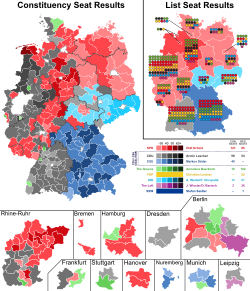Mixed-member proportional representation
In Germany, where it was differentiated from a different compensatory mixed system it was always known as personalized proportional representation (PPR) (German: personalisiertes Verhältniswahlrecht).In the Canadian province of Quebec, where an MMP model was studied in 2007,[6] it is called the compensatory mixed-member voting system (système mixte avec compensation or SMAC).In the United Kingdom the sometimes less proportional implementation of MMP used in Scotland and the London Assembly is referred to as the additional member system.The Scandinavian countries have a long history of using both multi-member districts (members elected through party-list PR) and nationally-based compensatory top-up seats using the same method as MMP, however because the local MPs are also elected using PR, these systems are not usually considered MMP as they are not mixed systems.Most of Germany changed to the two-vote variant to make local members of parliament (MPs) more personally accountable.[9] In each constituency, the representative is by default chosen using a single winner method (though this is not strictly necessary), typically first-past-the-post: that is, the candidate with the most votes (plurality) wins.In contrast, the open-list method of MMP was chosen in November 2016 by voters in the 2016 Prince Edward Island electoral reform referendum.For example, the provincial parliament (Landtag) of North Rhine Westphalia has, instead of the usual 50% compensatory seats, only 29% unless more are needed to balance overhangs.The compensatory effect characteristic of MMP is in the fact that a party that won constituency seats would have lower averages on the table than it would if the election used MMM.Countries which nominally use or have used MMP, but in practice had highly disproportional representation or it as otherwise not implemented are discussed in the next section.Countries with systems which have been confused with mixed-member proportional representation: In March 2004, the Law Commission of Canada proposed a system of MMP,[27] with only 33% of MPs elected from regional open lists, for the House of Commons of Canada[28] but Parliament's consideration of the Report in 2004–05 was stopped after the 2006 election.The Green Party of Canada has generally been a staunch supporter of a move to a proportional electoral system.In early 2017, the Government announced that it would accept only some of the committee's recommendations, and would not pursue the issue of electoral reform any further.[29][30] The pan-European party VOLT Europa proposes transnational mixed-member proportional representation with the combination of Majority Judgment and party-list PR.The election was condemned by the Organization for Security and Co-operation in Europe which said it failed to comply with international standards because of "serious irregularities", intimidation, vote-buying and "violence committed by extremists on both sides.The result of this approach, if it is used by all parties, would be to transform MMP into a de facto parallel voting mechanism.[further explanation needed] After the decoy list tactic withstood a constitutional challenge, Venezuela eventually formally reverted to a parallel voting system, which yields a lesser degree of proportionality compared to MMP.As a defensive move, the other coalition, Olive Tree, felt obliged to do the same, under the name Paese Nuovo.For example, the German moderate-right Free Democratic Party (FDP) has often received votes from voters who preferred the larger Christian Democratic Union (CDU) party, because they feared that if the FDP received less than 5% of the votes, the CDU would have no parliamentary allies and would be unable to form a government on its own.




Mixed-member majoritarian representationParallel votingGerman MMPSocial choiceelectoral systemsMechanism designComparative politicsComparisonBy countrySingle-winner methodspluralityFirst preference plurality (FPP)Two-roundJungle primaryPartisan primaryInstant-runoffCondorcet methodsCondorcet-IRVRound-robin votingMinimaxSchulzeRanked pairsMaximal lotteryPositional votingBorda countBaldwinAntipluralityCoombsCardinal votingScore votingApproval votingMajority judgmentSTAR votingProportional representationParty-listApportionmentHighest averagesLargest remaindersNational remnantBiproportionalList typeClosed listOpen listPanachageList-free PRLocalized listQuota-remainder methodsHare STVSchulze STVCPO-STVQuota BordaApproval-based committeesThiele's methodPhragmen's methodExpanding approvals ruleMethod of equal sharesFractional social choiceDirect representationInteractive representationLiquid democracyFractional approval votingRandom ballotSemi-proportional representationCumulativeLimited votingMixed systemsMixed-member majoritariancompensatoryParallel (superposition)CoexistenceFusion (majority bonus)Vote linkage systemNegative vote transferMixed ballotSupermixed systemsDual-member proportionalRural–urban proportionalMajority jackpotSingle voteDouble simultaneous voteDual-voteSpoiler effectCloning paradoxFrustrated majorities paradoxCenter squeezePerverse responseBest-is-worst paradoxNo-show paradoxMultiple districts paradoxStrategic votingLesser evil votingTruncationTurkey-raisingmajority ruleTyranny of the majorityDiscursive dilemmaConflicting majorities paradoxSocial and collective choiceImpossibility theoremsArrow's theoremMajority impossibilityMoulin's impossibility theoremMcKelvey–Schofield chaos theoremGibbard's theoremMedian voter theoremCondorcet's jury theoremMay's theoremVCG mechanismQuadratic votingmixed electoral systemswinner-take-allcompensatory tierparty listsrepresentativeconstituencyfirst-past-the-post votingparty-list proportional representationpolitical partiesproportional election resultsOverhang seatsNew Zealandmixed systemGermanydifferent compensatory mixed systemGermanlocalized